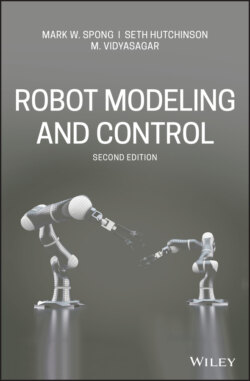Читать книгу Robot Modeling and Control - Mark W. Spong - Страница 4
CONTENTS
Оглавление1 Cover
2 Preface:
3 Chapter 1 Introduction 1.1 Mathematical Modeling of Robots 1.2 Robots as Mechanical Devices 1.3 Common Kinematic Arrangements 1.4 Outline of the Text Problems Notes and References Notes
4 Part I The Geometry of Robots Chapter 2 Rigid Motions 2.1 Representing Positions 2.2 Representing Rotations 2.3 Rotational Transformations 2.4 Composition of Rotations 2.5 Parameterizations of Rotations 2.6 Rigid Motions 2.7 Chapter Summary Problems Notes and References Notes Chapter 3 Forward Kinematics 3.1 Kinematic Chains 3.2 The Denavit–Hartenberg Convention 3.3 Examples 3.4 Chapter Summary Problems Notes and References Chapter 4 Velocity Kinematics 4.1 Angular Velocity: The Fixed Axis Case 4.2 Skew-Symmetric Matrices 4.3 Angular Velocity: The General Case 4.4 Addition of Angular Velocities 4.5 Linear Velocity of a Point Attached to a Moving Frame 4.6 Derivation of the Jacobian 4.7 The Tool Velocity 4.8 The Analytical Jacobian 4.9 Singularities 4.10 Static Force/Torque Relationships 4.11 Inverse Velocity and Acceleration 4.12 Manipulability 4.13 Chapter Summary Problems Notes and References Notes Chapter 5 Inverse Kinematics 5.1 The General Inverse Kinematics Problem 5.2 Kinematic Decoupling 5.3 Inverse Position: A Geometric Approach 5.4 Inverse Orientation 5.5 Numerical Inverse Kinematics 5.6 Chapter Summary Problems Notes and References
5 Part II Dynamics and Motion Planning Chapter 6 Dynamics 6.1 The Euler–Lagrange Equations 6.2 Kinetic and Potential Energy 6.3 Equations of Motion 6.4 Some Common Configurations 6.5 Properties of Robot Dynamic Equations 6.6 Newton–Euler Formulation 6.7 Chapter Summary Problems Notes and References Chapter 7 Path and Trajectory Planning 7.1 The Configuration Space 7.2 Path Planning for 7.3 Artificial Potential Fields 7.4 Sampling-Based Methods 7.5 Trajectory Planning 7.6 Chapter Summary Problems Notes and References Notes
6 Part III Control of Manipulators Chapter 8 Independent Joint Control 8.1 Introduction 8.2 Actuator Dynamics 8.3 Load Dynamics 8.4 Independent Joint Model 8.5 PID Control 8.6 Feedforward Control 8.7 Drive-Train Dynamics 8.8 State Space Design 8.9 Chapter Summary Problems Notes and References Notes Chapter 9 Nonlinear and Multivariable Control 9.1 Introduction 9.2 PD Control Revisited 9.3 Inverse Dynamics 9.4 Passivity-Based Control 9.5 Torque Optimization 9.6 Chapter Summary Problems Notes and References Notes Chapter 10 Force Control 10.1 Coordinate Frames and Constraints 10.2 Network Models and Impedance 10.3 Task Space Dynamics and Control 10.4 Chapter Summary Problems Notes and References Notes Chapter 11 Vision-Based Control 11.1 Design Considerations 11.2 Computer Vision for Vision-Based Control 11.3 Camera Motion and the Interaction Matrix 11.4 The Interaction Matrix for Point Features 11.5 Image-Based Control Laws 11.6 End Effector and Camera Motions 11.7 Partitioned Approaches 11.8 Motion Perceptibility 11.9 Summary Problems Notes and References Notes Chapter 12 Feedback Linearization 12.1 Background 12.2 Feedback Linearization 12.3 Single-Input Systems 12.4 Multi-Input Systems 12.5 Chapter Summary Problems Notes and References Notes
7 Part IV Control of Underactuated Systems Chapter 13 Underactuated Robots 13.1 Introduction 13.2 Modeling 13.3 Examples of Underactuated Robots 13.4 Equilibria and Linear Controllability 13.5 Partial Feedback Linearization 13.6 Output Feedback Linearization 13.7 Passivity-Based Control 13.8 Chapter Summary Problems Notes and References Note Chapter 14 Mobile Robots 14.1 Nonholonomic Constraints 14.2 Involutivity and Holonomy 14.3 Examples of Nonholonomic Systems 14.4 Dynamic Extension 14.5 Controllability of Driftless Systems 14.6 Motion Planning 14.7 Feedback Control of Driftless Systems 14.8 Chapter Summary Problems Notes and References Note
8 Appendix A Trigonometry A.1 The Two-Argument Arctangent Function A.2 Useful Trigonometric Formulas
9 Appendix B Linear Algebra B.1 Vectors B.2 Inner Product Spaces B.3 Matrices B.4 Eigenvalues and Eigenvectors B.5 Differentiation of Vectors B.6 The Matrix Exponential B.7 Lie Groups and Lie Algebras B.8 Matrix Pseudoinverse B.9 Schur Complement B.10 Singular Value Decomposition (SVD)
10 Appendix C Lyapunov Stability C.1 Continuity and Differentiability C.2 Vector Fields and Equilibria C.3 Lyapunov Functions C.4 Stability Criteria C.5 Global and Exponential Stability C.6 Stability of Linear Systems C.7 LaSalle’s Theorem C.8 Barbalat’s Lemma
11 Appendix D Optimization D.1 Unconstrained Optimization D.2 Constrained Optimization
12 Appendix E Camera Calibration E.1 The Image Plane and the Sensor Array E.2 Extrinsic Camera Parameters E.3 Intrinsic Camera Parameters E.4 Determining the Camera Parameters Note
13 Bibliography
14 Index
